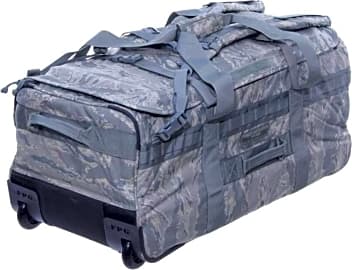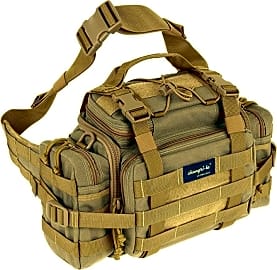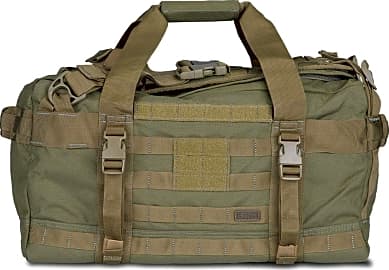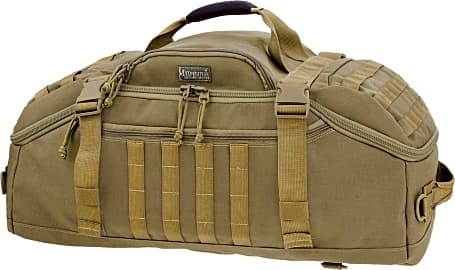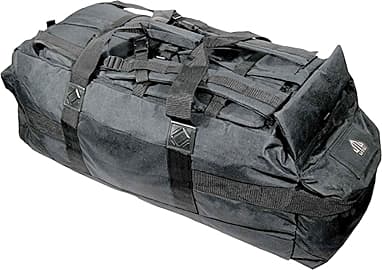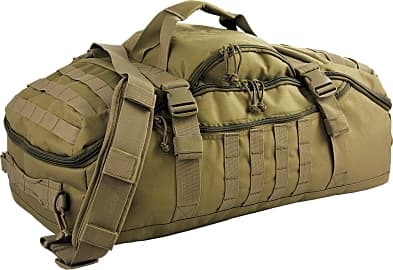The 10 Best Deployment Bags

This wiki has been updated 39 times since it was first published in July of 2015. If you're shipping out on your first tour of duty, allow us to salute you -- and also recommend one of these heavy-duty deployment bags, which will let you carry and protect as much gear as you need in as little space as possible. The options in this selection are tough enough to go anywhere you do, while keeping all your stuff organized at the same time. Adventurers may want a look at them, too. When users buy our independently chosen editorial picks, we may earn commissions to help fund the Wiki.
Editor's Notes
November 30, 2020:
For this update, we've added the ArmyCamo Heavy-Duty and the Sandpiper Loadout, two generously-sized models that offer great organizational features and are highly ranked. Another newcomer is the Shangri-La Outdoor Sling, a smaller bag that can be worn around the waist or slung over one shoulder.
The API USGI Sport has been taken off the list because its ratings have fallen and its classic design just can't stand up to updated models that are much more user-friendly. We've also removed the Voodoo Tactical Mini Mojo and the One Tigris Tactical because they are no longer available.
Finally, we've updated the information for several items, including the Forceprotector Collapsible, the Mercury Tactical Monster, and the Condor Colossus.
June 27, 2019:
When evaluating the best deployment bags we know that bigger is usually better, but we did limit the size choices to bags that should be able to be checked in with most airlines without incurring oversized baggage fees. We also chose to include the One Tigris Tactical, a carry-on sized option as a companion piece because of its potential usefulness while on deployment.
The Voodoo Tactical Mini Mojo belies its name by being quite large and takes the top spot for having an incredible array of pockets of varying sizes and an entire side of the bag covered in MOLLE webbing. We chose the “mini” version of the Voodoo Mojo over the very similar regular Voodoo Mojo because the larger bag's dimensions far exceed most airline size restrictions.
The Mercury Tactical Monster doesn't feature as many pockets or MOLLE webbing, but some may prefer this model because it's a little larger but should still be accepted by airlines without extra fees, plus this bag features three large rugged wheels that make it a lot easier to transport even when fully loaded.
A Brief Look At Historical Tactical Gear
Within a soldier's would have been, at a minimum, a cloak, a pot for cooking, a tin plate, a satchel for holding rations, and rudimentary utensils.
Little is known about prehistoric combat. Based on contemporary descriptions of and archeological evidence left by the so-called barbarian tribes that remained extant well into the Iron Age -- the era when other civilizations were rapidly developing into ordered societies -- it is safe to assume that the weaponry and gear used by the earliest groups of warriors were anything but uniform.
In the final few centuries before the Common Era commended, many armies began to adopt more standard armaments and gear, an approach that led to easier planning and execution of tactics on the field and easier logistical management of troops on the move, in camp, and in training. No military force of the ancient world better displayed this orderly approach to equipment than the legions of Rome. During the peak centuries of Roman power, roughly the years 200 BCE through the 4th Century CE, Roman soldiers dominated much of the known world, in no small part thanks to their high quality and uniform equipment.
The typical Roman soldier carried weaponry including the famed Gladius (a short sword) and a Pilum (a spear). The soldiers also wore nearly uniform armor, usually consisting of chain mail worn beneath segmented armor over the torso, with greaves often protecting the legs. The large shield carried by a Roman warrior was perhaps the greatest key to the success of the Roman army en masse; when grouped together, the shields produced a formidable wall.
One of the lesser-known but no less important pieces of gear carried by the Ancient Roman soldier was his sarcina, a Latin word simply meaning "pack." Within a soldier's would have been, at a minimum, a cloak, a pot for cooking, a tin plate, a satchel for holding rations, and rudimentary utensils. The sarcina, therefore, contained everything a soldier needed to make a bed and to cook and eat a meal; it was the forerunner of the modern soldier's deployment bag.
Soldiers have carried their gear in a variety of ways throughout the centuries separating Ancient Rome from the 21st Century. A knight riding off to the crusades in the 13th Century would have a loose leather satchel in which he likely carried a wooden cup and bowl, a piece of flint and steel for making fire, and often some devotional objects. During the American Civil War, soldiers carried their gear in a haversack which was usually made of canvas treated with tar to help it resist water. The haversack would hold cooking gear, rations, correspondence, tobacco, and more.
A soldier's gear carrying options improved throughout the 20th Century, with the principles of ergonomics and weight distribution marching in lockstep with the adoption of new and better materials. Today's soldier can bring his or her equipment toward the front line in a range of different deployment bags, and civilians too can benefit from them gear carrying advances made throughout the long years of military endeavor.
Using A Deployment Bag For Travel
There are many reasons the recreational (or business) traveler might opt for a deployment bag instead of a more standard piece of luggage, such as a roll-aboard suitcase or a duffel bag. Unlike most duffel bags, which tend to feature only a few pockets, most deployment bags feature multiple compartments, making it easy to keep your belongings sorted and organized.
While not suitable for multiple-day, multiple-mile hiking trips, many deployment bags are a great choice for the camper with a relatively short trek into their campsite.
And unlike many rolling bags, most deployment bags are easily slung over the shoulder or even worn as a backpack, features you will appreciate when the smooth, paved roads and sidewalks end and you're hiking over varied terrain.
For the traveler who will pass through and over everything from the airport to the city to the sandy beach during his or her travels, a deployment bag with wheels, a handle, and a shoulder strap is a great idea. These varied options allow you to always carry your gear in the most convenient manner.
While not suitable for multiple-day, multiple-mile hiking trips, many deployment bags are a great choice for the camper with a relatively short trek into their campsite. Their divided compartments can be used to separate clean clothes from dirty clothes, and they can carry enough gear, including provisions, flashlights, first aid kits, and so forth, for many days in the field.
Choosing A Deployment Bag For Tactical Use
If you're a soldier packing your gear prior to an actual deployment or a first responder readying your kit for emergency response (or you're a survival-minded person looking to have a kit ready in the event of a disaster), it's a good idea to first consider all the gear that's essential to your situation, then to choose a deployment bag into which to pack it.
For the soldier who is likely to march for miles with all their gear, a bag that can be worn comfortably and which features multiple easy adjustment points is critical.
Deployment bags vary widely in size and storage capacity, and many that look large may feature smaller actual cargo space than you think based on how many pockets and compartments they have. Make sure you consider the size of each slot or pocket in a bag and consider the gear you need to stow rather than looking at a deployment bag's overall size.
Also consider which is more important to you given the situations you might face: ease of access, or ease of carrying. If you're an emergency responder, chances are you will only be carrying your bag a short distance after exiting an ambulance, helicopter, or another vehicle, thus a bag that is easy to open and access is crucial. For the soldier who is likely to march for miles with all their gear, a bag that can be worn comfortably and which features multiple easy adjustment points is critical.




